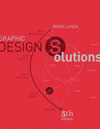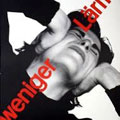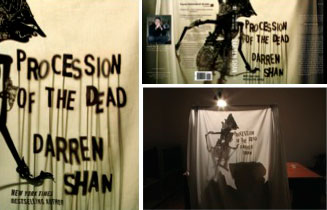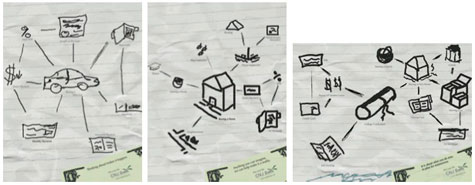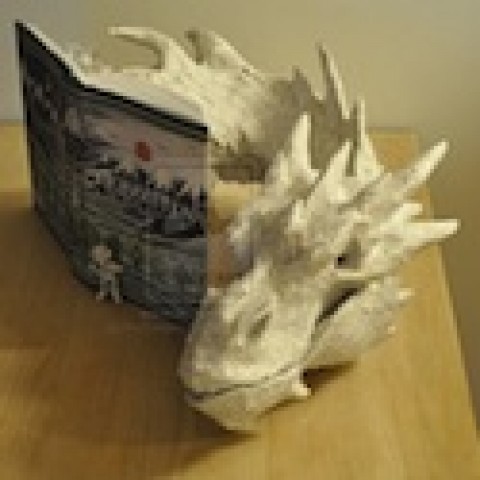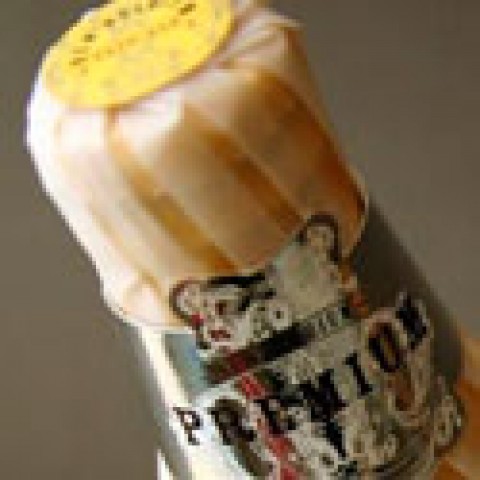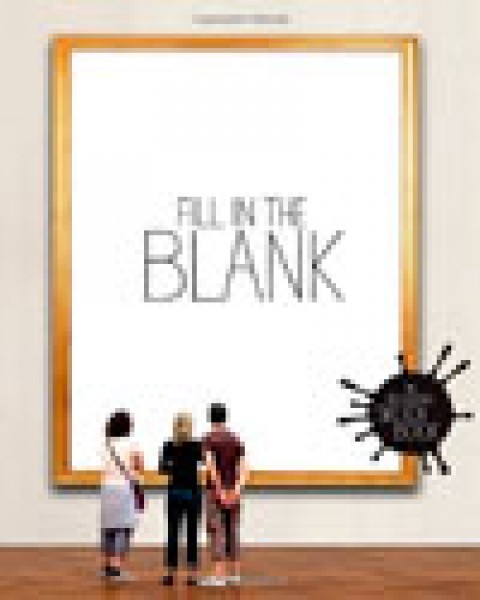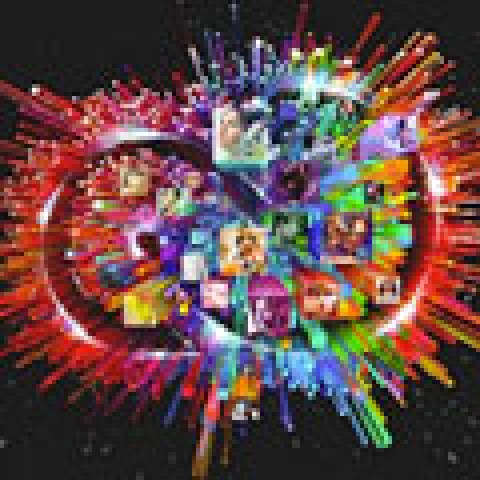[Editor’s Note: In the following excerpt from the 5th Edition of “Graphic Design Solutions”, Robin Landa reintroduces us to the nitty-gritty of creativity. In the process, she forces us to realize that creativity isn’t some mysterious force that is either inside us (or not) from day to day, but a skill that can be honed and refined in several different ways.]
Of all the competencies necessary to be a graphic designer, creativity is the most elusive. Developing your creativity will enhance everything you do—from graphic design to how you live your life.
Synthetic creative thinking is the skill to construct original ideas and novel relationships, to be innovative, and to be flexible in one’s thinking. Imaginative designers learn to think differently and are able to generate relevant creative design solutions. For example, Catherine Casalino’s inspiration for the “Procession of the Dead” book cover was based on a scene with shadow puppets.
BOOK JACKET, PROCESSION OF THE DEAD
- Design and Photography: Catherine Casalino
- Publisher: Grand Central Publishing
“The inspiration for the cover was a scene in the book with shadow puppets. The shadow letters were created by placing metal letters on wooden skewers behind a sheet. The whole setup was then lit from behind and photographed.”
—Catherine Casalino
Facets of creative thinking are:
- associative thinking (recognizing commonalities, common attributes)
- metaphorical thinking (identifying similarities between seemingly unrelated things)
- elaboration and modification (working out details and proposing alterations)
- imaginative thinking (forming images in one’s mind and imagining unlikely objects or events).
CHARACTERISTICS OF CREATIVE THINKERS
Certain characteristics are markers of creative thinking:
- Courage: Fear quashes creative risk taking and supports playing it safe. Courage coupled with intellectual curiosity fuels creativity.
- Receptiveness: Being open to different ways of thinking as well as constructive criticism allows you to embrace possibilities and new ideas.
- Curiosity: The desire to know and to explore allows one to grow intellectually, artistically, and technically.
- Flexibility: Not only do an agile mind and flexible personality allow you to keep up with the times, but these characteristics also allow you to bend with the path of a budding idea or let go of a path that is not fruitful.
- Being Sharp-Eyed: Paying attention to what you see every day (shadows, juxtapositions, color combinations, textures, found compositions, peeling posters, etc.) allows you to see inherent creative possibilities in any given environment; you notice what others miss or do not think noteworthy.
- Seeking and Recognizing Connections: Creative people have the skills to bring two related or unrelated things together to form a new combination or relationship. They arrange associative hierarchies in ways that allow them to make connections that might elude others.
TOOLS THAT STIMULATE CREATIVE THINKING
There are tools that aid creative thinking. Besides using these creativity techniques for concept generation, some designers and students use them as visualization and spontaneous com- positional tools.
Brainstorming (Group or Individual Tool)
In “Your Creative Power,” published in 1945, Alex Osborn, an advertising partner at BBDO in New York, presented a technique he had been using for years at BBDO: brainstorming. The objective of Osborn’s technique was to generate ideas that could be solutions to advertising problems. Traditional brainstorming is conducted with a group of people so that one contributor’s thought builds on or triggers another’s, although it may even work better when modified for individual use, since there is no holding back when one is alone. An uninhibited atmosphere cultivates the flow of creative thinking.
Osborn’s Checklist (Individual Tool)
In the mid-1960s, American artist Richard Serra began experimenting with nontraditional materials, including fiberglass, neon, vulcanized rubber, and lead. He combined his examination of these materials and their properties with an interest in the physical process of making sculpture. The result was a list of action verbs Serra compiled—“to roll, to crease, to curve”— listed on paper and then enacted with the materials he had collected in his studio. “To Lift” by Serra, “made from discarded rubber recovered from a warehouse in lower Manhattan, is a result of the rubber’s unique response to the artist’s enacting of the action verb ‘to lift.’”
“It struck me that instead of thinking what a sculpture is going to be and how you’re going to do it compositionally, what if you just enacted those verbs in relation to a material, and didn’t worry about the results?” —Richard Serra
Before Serra’s sculptural experiments, Alex Osborn, who developed brainstorming, created an inspired checklist technique as a tool to transform an existent idea or object. Arguably, this could be the only tool you ever need to foster creative thinking. In short, Osborn’s checklist is composed of action verbs:
- Adapt
- Modify
- Magnify
- Minimize
- Substitute
- Rearrange
- Reverse
MAPPING (INDIVIDUAL TOOL)
A mind map is a visual representation or diagram of the various ways words, themes, images, thoughts, or ideas can be related to one another. Mapping is a brainstorming and visual diagramming tool that is used to develop an idea or lead to an idea; it is also called word mapping, idea mapping, mind mappingTM, word clustering, and spider diagramming. It can be used to visualize, structure, and classify ideas and as an aid in study, organization, problem solving, and decision making. A resulting visual map is a diagram that represents thoughts, words, information, tasks, or images in a specific diagrammatic arrangement. There is a central key word or thought, and all other words, thoughts, or visuals stem from and are linked to the central idea in a radius around that central focal point.
TYPES OF MIND MAPS
Mapping is a useful tool for the writing process, design process, brainstorming process, exploring relationships, or simply for thinking something through. You can approach mapping in two basic ways:
- Automatic mapping relies heavily on the surrealist strategy of spontaneous free association, trying to avoid conscious choices and allowing associations to flow freely.
- Deliberate mapping relies more on the natural growth of associations, revealing the way your mind instinctively organizes or makes associations.
A mind map is a tangible representation of associations that may reveal an insight or lead to an idea. You can rearrange items to create a new beginning (central word or image), reordering subtopics (secondary items), sub-subtopics (tertiary items), and so on. You can remap based on a deeper understanding derived from the first go-round or based on something that occurred to you while mapping. You can articulate a section of connections or see links among items on the map.
HOW TO CREATE A MIND MAP
Mapping software is available that offers templates, shuffling, notes, labels, cross-linking, and more. However, since the nature of the drawing process maximizes spontaneous mapping, doing it by hand offers superior outcomes. Drawing your own map assures personalization and a natural flow of thoughts.
- Position an extra large sheet of paper in landscape position.
- At the center of the page, your starting point, draw a key visual or write a key word, topic, or theme.
- Starting with the central word or image, draw branches (using lines, arrows, any type of branch) out in all directions making as many associations as possible. Don’t be judgmental; just write or draw freely.
Each subtopic should branch out from the major central topic. Then, each sub-subtopic or image should branch out from the subtopic and continue branching out on and on. Seek relationships and generate branches among as many items as possible. Feel free to repeat items and/or cross-link.
Spontaneous mapping draws upon the unconscious. Write or draw as quickly as possible without deliberating or editing. This type of mapping promotes nonlinear thinking. Interestingly, it can be the most unforeseen item or possibility that becomes a key to idea generation. Deliberate mapping utilizes long and careful thinking. As a complement, you could consider note taking—writing down some explanatory notes near the items or branches so that later, when you reexamine the map, you can more easily recall exactly what you were thinking. The ad campaign in Robert Skwiat’s senior portfolio was based on a mind map [below].
…………..

